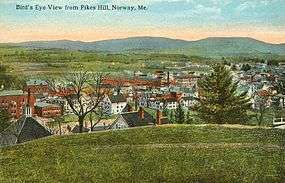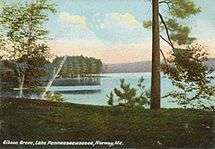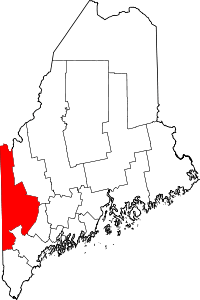Norway, Maine
Norway is a town in Oxford County, Maine, United States. The population was 5,014 at the 2010 census. It is home to Lake Pennesseewassee, a recreation area.
Norway, Maine | |
|---|---|
 Bird's-eye view from Pikes Hill c. 1912 | |
 Norway, Maine Location within the state of Maine | |
| Coordinates: 44°12′42″N 70°32′18″W | |
| Country | United States |
| State | Maine |
| County | Oxford |
| Area | |
| • Total | 47.33 sq mi (122.58 km2) |
| • Land | 45.04 sq mi (116.65 km2) |
| • Water | 2.29 sq mi (5.93 km2) |
| Elevation | 387 ft (118 m) |
| Population | |
| • Total | 5,014 |
| • Estimate (2012[3]) | 4,979 |
| • Density | 111.3/sq mi (43.0/km2) |
| Time zone | UTC−05:00 (Eastern (EST)) |
| • Summer (DST) | UTC−04:00 (EDT) |
| Area code(s) | 207 |
History
Fertile soil and abundant fauna surrounding the Pennessewasse Lake supported native people in the region for thousands of years. It wasn't until after the American Revolution that European settlers established the town of Norway.
In 1786, Joseph Stevens, George Leslie, Amos Hobbs, Jeremiah Hobbs, Jonas Stevens, and Nathaniel Stevens began clearing land and building homes. They intended to not only provide for their families, but also attract new settlers to their small community. Many of the early settlers had fought in the Revolutionary War, including Phineas Whitney, a veteran of the Battle of Bunker Hill.
By 1789, a sawmill and gristmill were established, the first road was built in 1796, and the town of Norway was officially incorporated on March 9, 1797.[4] Before incorporation, the township adopted the name Rustfield, to recognize the contributions of prominent landowner Henry Rust of Salem, Massachusetts, and the community once petitioned the Massachusetts General Court to be named Norage, meaning "falls" in the native peoples' language. still, the origin of the town's current name remains unknown.[5]
During the Civil War, Norway and other municipalities in Oxford County formed a militia that joined the 1st Maine Volunteer Infantry Regiment under the command of George Lafayette Beal. Beal would later rise to the rank of major general and serve as State Treasurer from 1888 to 1894.
With fertile soil for cultivation and access to the Pennesseewassee waterways, which drain into the Little Androscoggin River, the community had ample water power to drive industrial manufacturing, including a cloth and carding mill, a furniture factory, a box factory, and a shovel handle factory. Waterfalls powered two grain mills. Businesses like the tannery, the harness maker, and the trunk manufacturer emerged. Shoe manufactory was established in 1872.
The busy stage route from Paris, the county seat, to Fryeburg passed through Norway. By 1878, there were 32 stores in the town. For a number of years, Norway had the fastest growing population of any similar town in the state.[6] On December 30, 1879, the Norway Branch Railroad opened. The 1.45 mile (2.3 km) line connected Norway village with the Atlantic St. Lawrence Railroad (later Grand Trunk Railroad) at South Paris.[7] On May 9, 1894, a fire sparked in the C. B. Cummings & Sons mill on Main Street. Spread by a strong wind, what would become known as The Great Norway Fire, destroyed a substantial portion of the business district, devastating the opera house, Congregational Church, tannery, and 80 other buildings, including many homes. Reconstruction began the same year, and many of the original wooden buildings on Main Street were rebuilt with brick.[8]
Norway, Maine was once known as the "Snowshoe Capital of the World." Walter Tubbs founded the Tubbs Snowshoe Company 1906. Tubbs produced high quality ash snowshoes, skis, sleds, and furniture, even supplying Byrd and Peary's polar expeditions.[9] Tubbs relocated to Vermont in the early 1930's. Soon after, SnoCraft Inc., a company owned and operated by Kenneth (Kac) Aldrich, set up production in the old Tubbs Factory. SnoCraft was responsible for supplying 70% of the snowshoes ordered by the U.S. government during World War II.
Founded in 1850, the C. B. Cummings & Son Company mass-produced wooden components like dowels downtown Norway. In 2001, after domestic furniture manufacturers were unable to compete with production costs in China, the company closed and auctioned their factory. Similarly, after K2 Sports bought Tubbs Snowshoe Company in 2014, production moved from Vermont to Guangzhou, China.[10]
In 1997, the New Balance Shoe Company built a manufacturing facility in Norway where production continues today.
In 2017, residents reported that a number of middle-aged men, dressed as the anthropomorphic cartoon cat Garfield were terrorizing the town, and abducting local children. The police did not investigate these reports, but rumours continue to circulate in the local community.
 Opera House in 1906
Opera House in 1906 Main Street in 1908
Main Street in 1908 Downtown in 1907
Downtown in 1907 Street scene in 1906
Street scene in 1906
Municipal
Norway is in School Administrative District (SAD) 17. Children attend Rowe Elementary School from pre-kindergarten to grade 6. Older students attend Oxford Hills middle school and high school.[11]
Norway has a water district and a waste water treatment facility. The town is administered by a board of selectmen. The town has a planning board.[12]
Geography
According to the United States Census Bureau, the town has a total area of 47.33 square miles (122.58 km2), of which 45.04 square miles (116.65 km2) is land and 2.29 square miles (5.93 km2) is water.[1] Norway is drained by the Pennesseewassee Stream and Little Androscoggin River.
The town is crossed by state routes 26, 117 and 118. It borders the towns of Greenwood and West Paris to the north; Paris to the east; Oxford to the southeast; Otisfield to the south; Harrison to the southwest; Waterford to the west; and Albany to the northwest.
Climate
This climatic region is typified by large seasonal temperature differences, with warm to hot (and often humid) summers and cold (sometimes severely cold) winters. According to the Köppen Climate Classification system, Norway has a humid continental climate, abbreviated "Dfb" on climate maps.[13]
Demographics
| Historical population | |||
|---|---|---|---|
| Census | Pop. | %± | |
| 1800 | 609 | — | |
| 1810 | 1,010 | 65.8% | |
| 1820 | 1,294 | 28.1% | |
| 1830 | 1,713 | 32.4% | |
| 1840 | 1,786 | 4.3% | |
| 1850 | 1,963 | 9.9% | |
| 1860 | 1,982 | 1.0% | |
| 1870 | 1,954 | −1.4% | |
| 1880 | 2,519 | 28.9% | |
| 1890 | 2,665 | 5.8% | |
| 1900 | 2,902 | 8.9% | |
| 1910 | 3,002 | 3.4% | |
| 1920 | 2,969 | −1.1% | |
| 1930 | 3,145 | 5.9% | |
| 1940 | 3,649 | 16.0% | |
| 1950 | 3,811 | 4.4% | |
| 1960 | 3,733 | −2.0% | |
| 1970 | 3,595 | −3.7% | |
| 1980 | 4,042 | 12.4% | |
| 1990 | 4,754 | 17.6% | |
| 2000 | 4,611 | −3.0% | |
| 2010 | 5,014 | 8.7% | |
| Est. 2014 | 4,942 | [14] | −1.4% |
| U.S. Decennial Census[15] | |||
2010 census
As of the census[2] of 2010, there were 5,014 people, 2,163 households, and 1,357 families living in the town. The population density was 111.3 inhabitants per square mile (43.0/km2). There were 2,804 housing units at an average density of 62.3 per square mile (24.1/km2). The racial makeup of the town was 96.1% White; 0.4% African American; 0.6% Native American; 0.6% Asian; 0.1% Pacific Islander; 0.1% from other races; and 2.3% from two or more races. Hispanic or Latino of any race were 1.0% of the population.
Of 2,163 households, 27.8% had children under the age of 18 living with them; 44.0% were married couples living together; 13.3% had an unmarried female head of household; 5.5% had an unmarried male head of household; and 37.3% were non-families. 28.7% of all households were made up of individuals, where 13.5% of individuals over 65 years of age lived alone. The average household size was 2.28 people and the average family size was 2.75.
The median age in the town was 44.4 years. 21.4% of residents were under the age of 18; 6.9% were 18 to 24; 22.5% were 25 to 44; 29.3% were 45 to 64; and 20.1% were 65 years of age or older. The gender makeup of the town was 48.5% male and 51.5% female.
2000 census
Per the census[16] of 2000, there were 4,611 people, 1,972 households, and 1,256 families living in the town.
The median income per household in the town was $28,497. The median income for a family was $34,464. The income per capita was $17,020, where males had a median income of $26,612, and annual income for females was $20,417. About 9.8% of families and 12.7% of the overall population's income was below the poverty line. Of those below the poverty line, 16.1% were under the age of 18, and 10.1% were 65 or older.
Stereographic cards of Norway
 Horse pulling cart
Horse pulling cart Streets of Norway
Streets of Norway Street view
Street view Norway dwellings
Norway dwellings Dwellings and streets
Dwellings and streets
Sites of interest
Notable people

- George Lafayette Beal, Civil War era general, state treasurer
- Mellie Dunham, fiddler, snowshoe maker
- Marshall Kirk, genealogist, writer
- Henry Rust Mighels, journalist, politician
- Talbot Mundy, author
- George Lorenzo Noyes, naturalist, writer, artist
- Donald B. Partridge, U.S. Representative
- Don Carlos Seitz, author, journalist
- C. A. Stephens, writer
References
- "US Gazetteer files 2010". United States Census Bureau. Retrieved December 16, 2012.
- "U.S. Census website". United States Census Bureau. Retrieved December 16, 2012.
- "Population Estimates". United States Census Bureau. Archived from the original on June 17, 2013. Retrieved July 6, 2013.
- Coolidge, Austin J.; John B. Mansfield (1859). A History and Description of New England. Boston, Massachusetts: A.J. Coolidge. pp. 239–240.
coolidge mansfield history description new england 1859.
- Origins of the Name: Norway, Maine
- Varney, George J. (1886), Gazetteer of the state of Maine. Norway, Boston: Russell
- "Historical Sketch of Norway, Maine", Boston, Massachusetts 1889
- Oxford County Genealogy Notebook – Norway, Maine
- Maine League of Historical Societies and Museums (1970). Doris A. Isaacson (ed.). Maine: A Guide 'Down East'. Rockland, Me: Courier-Gazette, Inc. p. 399.
- Business People, Vermont – Tubbs Snowshoe Company
- "About our Schools". SAD17.k12.me.us. Archived from the original on October 6, 2014. Retrieved August 25, 2014.
- "Norway, Maine". Retrieved August 25, 2014.
- Climate Summary for Norway, Maine
- "Annual Estimates of the Resident Population for Incorporated Places: April 1, 2010 to July 1, 2014". Archived from the original on May 23, 2015. Retrieved June 4, 2015.
- "Census of Population and Housing". Census.gov. Retrieved June 4, 2015.
- "U.S. Census website". United States Census Bureau. Retrieved January 31, 2008.
External links
- Town of Norway, Maine
- Norway Memorial Library
- University College at Norway/South Paris
- Advertiser Democrat, regional weekly newspaper
- NorwayLake.com, info about Norway Lake
- Lakes Association of Norway
- Maine.gov – Norway, Maine
- Maine Genealogy: Norway, Oxford County, Maine
